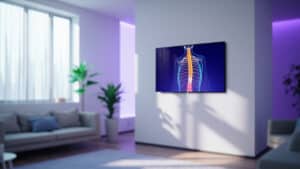Can A Bulging Disc Get Worse? A Physician’s Evidence-Based Approach
Written by Dr. Matthias Wiederholz, MD, Quadruple Board-Certified in Physical Medicine & Rehabilitation, Pain Medicine, Sports Medicine, and Regenerative Medicine.
Quick Insights
What is a bulging disc? A bulging disc occurs when spinal disc material protrudes, but the disc wall stays intact. If left unmanaged, symptoms or nerve pressure can become more severe over time, making early intervention essential according to expert guidelines. Learn more.
Key Takeaways
- Bulging discs may worsen due to repetitive strain, lack of activity, or advancing age. Certain physical activities that strain the back can increase risk.
- Warning signs include new or increasing pain, numbness, muscle weakness, or changes in your ability to stay active.
- Most bulging discs are managed without surgery initially, with various non-surgical treatments aimed at improving patient outcomes.
- Early diagnosis and evidence-based care can help most people continue leading active, independent lives.
Why It Matters
Understanding if a bulging disc can get worse empowers you to take action before pain disrupts your life. Prompt, informed care supports staying active, reassures against surgical fears, and helps protect your long-term independence and quality of life.
As a quadruple board-certified regenerative spine specialist, I see every week just how much a bulging disc can disrupt an active life in Houston. Learn more about transformative spine repair options like the Discseel® Procedure as part of our innovative treatment offerings at Performance Pain and Sports Medicine.
A bulging disc is when the soft cushioning between your vertebrae pushes outward—the wall stays intact, but the disc’s shape changes and may press on nerves. Many people worry, “Can a bulging disc get worse?” The answer: yes, if left unchecked, symptoms such as pain, weakness, and numbness can progress or flare up, especially with repetitive strain, aging, or a lack of movement.
I’ve worked with countless patients frustrated by limitations—sports sidelined or family activities missed—and have seen firsthand that early, evidence-based care for disc injuries often stops things from getting worse and helps most avoid surgery entirely. You can read more about my patient-focused approach and expertise in regenerative spine treatments by visiting my doctor bio.
If you’re anxious about your future mobility or already fearing your disc symptoms are spiraling, you’re in the right place for answers and real solutions.
Before we dive into the details, if you’re seeking guidance for back issues, see our back pain solutions for further resources.
Can A Bulging Disc Get Worse? (Quick Answer & Overview)
A bulging disc (when the disc’s soft center pushes outward but the tough outer wall remains intact) can absolutely get worse if left unmanaged. In my experience working with active adults in Houston, I frequently see patients whose symptoms started out mild but gradually intensified when early warning signs were missed or care was delayed. Over time, factors such as repeated strain or insufficient healing may contribute to the progression of a bulging disc, potentially increasing nerve pressure, intensifying pain, or leading to disc herniation.
Scientific evidence confirms that, especially when aggravated by ongoing mechanical stress or natural age-related degeneration, bulging discs can progress—causing increasing discomfort, restricted movement, and the risk of chronic pain conditions (regular physical activity and rehabilitation can help reduce pain and improve outcomes in degenerative disc disease).
As a quadruple board-certified regenerative medicine specialist, I’ve found that early, evidence-based intervention—such as targeted physical therapy and other non-surgical treatments—can often halt or even reverse this progression before permanent nerve or disc damage occurs.
So, can a bulging disc get worse? Yes, particularly if symptoms are ignored or aggravating activities continue. The good news: with timely, personalized care, most patients can prevent further damage and reclaim an active lifestyle. For more about when pain signals a bigger problem, see the guide to spinal disc tears: causes, symptoms, and treatment options.
What Causes a Bulging Disc to Worsen?
A bulging disc can worsen due to a mix of lifestyle choices, underlying health issues, and the natural aging process. From an expert perspective, understanding what intensifies these risks allows us to intervene early and preserve long-term spine health.
Lifestyle Factors and Daily Activities
Day-to-day habits have a powerful effect—repetitive bending, poor posture, heavy lifting, and prolonged sitting all add pressure to spinal discs. As a Houston spine specialist, I frequently see athletes and active adults whose symptoms worsen after pushing through pain or resuming activity too quickly. High-impact sports, improper lifting, and sudden twisting motions can accelerate disc bulging.
Expert Insight:
Having personally performed over 10,000 regenerative spine procedures, I’ve seen that teaching patients the right way to move—focusing on core strengthening, balance, and proper lifting mechanics—can dramatically reduce disc pressure and pain. Most importantly, it helps keep people on the courts, trails, and playing fields they love.
Contrary to the common fear that activity is always harmful, research shows that regular, targeted exercise—when guided by a specialist—protects your discs by improving function and reducing pain in degenerative disc conditions (rehabilitation and physical activity in lumbar DDD). Discover safe, effective herniated disc exercises to support recovery without increasing risk.
Underlying Medical Conditions
Obesity, diabetes, and chronic inflammation weaken the structural integrity of spinal discs. Smoking, a factor I see all too often, reduces blood flow and slows healing, leading to faster degeneration. Clinically, these patients usually require a broader, multidisciplinary approach to prevent progression.
Professional Assessment:
As a quadruple board-certified regenerative medicine specialist, I’ve observed that patients with metabolic or inflammatory conditions see the best long-term results when we address both spine health and these underlying factors together. Consider reading about degenerative disc disease treatment options if you have related concerns.
Natural Disc Degeneration with Age
Aging naturally dries out discs, making them more brittle and prone to bulging or fissuring (small tears in the tough outer wall). Emerging research links disc degeneration and annular fissures to the progression of pain and disability (degenerative spine changes with age; disc deformation and annular fissuring).
Clinical Observation:
In my Houston practice, patients are often surprised to learn that spinal aging is not entirely preventable—but proactive management can absolutely slow progression and maintain independence much longer.
Key advice: If you’re noticing more stiffness or post-activity pain as you age, that’s a strong sign to seek informed, proactive care.
For a deeper dive into what worsens a herniated disc and underlying mechanisms, see what worsens a herniated disc: symptoms, causes, and treatment.
Wondering what signals that your own disc is worsening? Let’s examine the warning signs.
Recognizing When a Bulging Disc Is Getting Worse
Actively monitoring your symptoms is vital—early recognition is the single best way to avoid lasting nerve injury or function loss. My approach always includes clear education on what to watch for and when to act.
Key Warning Signs
Watch for these red flags indicating disc progression:
- New or increasing back/neck pain.
- Tingling, numbness, or weakness in arms or legs.
- Trouble walking, standing, or doing usual activities.
- Any loss of bladder or bowel control (rare, but urgent).
If any of these symptoms appear, they may signal that the bulging disc is exerting more pressure on your nerves or triggering inflammation in surrounding tissues. National clinical guidelines stress that worsening neurological symptoms—especially weakness or bladder/bowel changes—require immediate evaluation (clinical guidance on lumbar disc herniation).
Experience-Based Insight:
I’ve seen time and time again that patients who respond quickly to new or progressing symptoms recover faster and are more likely to avoid surgery. Delaying care rarely works in your favor and can make active rehabilitation more difficult later.
For additional red flag symptoms and emergency preparations, review our post on emergency symptoms of a herniated disc.
When to Seek Immediate Help
Sudden, severe pain, quickly worsening weakness, or loss of bladder or bowel control can signify serious nerve compression. Do not wait—seek medical help right away.
Most warning signs develop over time and start subtly; sometimes it’s a gradually shrinking walking distance, a twinge during workouts, or routine chores feeling harder. If any doubt, reach out—there’s no downside to early evaluation.
So what are the most effective ways to manage a worsening bulging disc? Let’s break down your options.
Conservative vs. Advanced Treatments: What Are Your Options?
Bulging disc treatment is never one-size-fits-all. The right approach reflects your symptoms, goals, and how much function you need to reclaim. I always develop a plan that’s as unique as each patient—balancing hands-on rehabilitation with breakthrough regenerative options when needed.
Physical Therapy and Home Management
For most patients, the first line of defense is conservative care:
- Structured physical therapy (core, posture, spinal stabilization).
- Ergonomic changes at work/home.
- Temporary anti-inflammatory medication.
- Strategic rest (but never complete inactivity).
Research confirms that targeted exercise and rehabilitation are core to successful bulging disc management—they relieve nerve compression, strengthen supporting muscles, and restore safe movement (targeted exercise regimens for disc compression).
Clinical Observation:
In my practice, those who fully commit to a structured, expert-guided rehab program tend to recover faster—often without ever needing surgery. I always pair hands-on therapy with education and motivation, because an active partnership drives the best outcomes.
For guidance on creating a spine-friendly routine, see herniated disc exercises.
When Is Surgery Considered?
Surgery is typically reserved for patients with:
- Disabling or persistent pain despite maximal conservative therapy.
- Worsening nerve involvement (e.g., progressive weakness).
- Severe spinal instability.
Clinical research highlights that early surgery can yield excellent recoveries for select patients with moderate motor deficits, but remains the exception, not the rule (outcomes and indications for surgery vs. conservative management).
Comparative Expertise:
Unlike larger clinics where surgical decision-making may be rushed or inconsistent, I guide every patient through a detailed, stepwise approach—conservative care first, advanced non-surgical options next, and surgery only if absolutely warranted. Review the L5-S1 herniated disc surgery overview for related surgical considerations.
Regenerative Approaches (Including Discseel®)
When conservative care alone isn’t enough, regenerative medicine changes the game. Newer options like Discseel® use biologic materials to repair and seal discs, directly targeting the root cause instead of just symptom management.
Recent medical reviews show that regenerative therapies and biomaterials—even advanced injectable options—can promote healing and restore disc function for patients who, previously, had only surgery as an option (regenerative Discseel® and long-term outcomes).
Professional Assessment:
As one of the world’s few Discseel® Master Instructors and a pioneer in non-surgical disc repair, I’ve helped hundreds of patients bypass major surgery—getting back to running, golf, and family life much sooner than they expected.
If you feel stuck with slow progress or increasing disability, regenerative spine solutions could be your next step. For insights into non-surgical disc repair, read disc tear treatment: restoring the integrity of your spine.
Discseel®: A Revolutionary Non-Surgical Solution (Houston Exclusive)
Discseel® Procedure Infobox
– Minimally invasive, no incisions or hardware.
– Repairs leaking/bulging discs using biologic fibrin sealant.
– 82% success rate for pain relief and mobility.
– Rapid return to activity, usually within days.
– Houston’s only Master Instructor-led program.
Discseel® is an FDA-compliant, outpatient procedure that repairs and strengthens damaged discs using a bioengineered fibrin sealant. As a Master Instructor directly trained by Discseel® inventor Dr. Kevin Pauza, I’m honored to offer this world-class solution exclusively in Houston.
Explore more about regenerative options on our Discseel® treatment page.
How Discseel® Works
The procedure precisely injects a fibrin sealant into the annulus fibrosus (the disc’s tough outer layer) using advanced imaging for targeting. The sealant closes annular fissures (tiny disc wall tears), stops inflammatory responses, and prompts natural collagen regeneration. This stabilizes the disc environment and reduces pain at the source.
Leading studies validate that Discseel® and similar regenerative therapies offer significant, long-term improvements for patients with persistent disc pain, even following failed surgery (clinical data on Discseel® and fibrin sealant outcomes).
Furthermore, new biomedical innovations support using biomaterials like fibrin and specialized scaffolds to promote disc tissue regrowth and reverse degeneration—promising a future where surgery could become even less necessary (biomaterial-driven disc regeneration).
To read reviews from patients who’ve found lasting relief, see our post on Discseel® reviews: achieving lasting back pain relief.
Benefits Over Traditional Surgery
Discseel® stands apart through multiple unique advantages:
- No general anesthesia, hospital stay, or hardware required.
- Outpatient setting, total time under 60 minutes.
- Preserves spinal mobility rather than limiting it (no fusion).
- Directly addresses leaking or degenerated discs—the root cause.
Experience-Based Insight:
Across thousands of procedures, I’ve seen patients regain mobility, sleep better, and reclaim active hobbies after years of failed conservative treatments or unsuccessful surgeries. Restoring both confidence and spinal integrity is what truly changes lives.
Who Is a Candidate?
Discseel® may be the ideal solution if you:
- Suffer from bulging/herniated discs or annular tears.
- Still have pain after failed back surgery or years of conservative therapy.
- Want to avoid traditional surgery and preserve spine flexibility.
All candidates go through a personalized MRI review, biomechanical assessment, and a thorough discussion of goals and expectations.
Patient Experience: Real-World Hope
“After years of back pain, Dr. Wiederholz was the only specialist who listened, explained what was happening in detail, and walked me step by step through the Discseel® Procedure. In just a few weeks, I was back on my feet, pain-free, and more active than I’ve been in years. If you are in Houston and want compassionate, effective disc treatment, this is the place.”
— Paul H., Houston (see original Google review)
What Our Patients Say on Google
Patient experiences are at the heart of my approach to spine care. Every individual’s journey with a bulging disc is unique, and I strive to ensure that each patient feels heard, informed, and empowered throughout their treatment.
I recently received feedback that captures what we aim to provide in our Houston clinic. This reviewer shared their perspective after working with me on their pain management journey:
“ My personal experience with Dr. Wiederholz – based on both appointments and other communications – has been fantastic. He seems to be determined to make sure you understand your own pain issues and treatment options. He will answer every question you may have, without making you feel like he is getting impatient. I highly recommend him, without reservation.”
— Paul
Read more Google reviews here
Hearing this kind of feedback reinforces my commitment to clear communication and patient-centered care—especially when guiding patients through the complexities of bulging disc progression and advanced treatment options. Discover additional experiences in our comprehensive guide to L5-S1 bulging disc.
Bulging Disc Care in Houston, TX
Living in Houston, TX, means access to some of the most advanced spine care options in the country, including the latest non-surgical treatments for bulging discs. The city’s active lifestyle and diverse population often bring unique challenges, from sports injuries to the demands of physically intensive jobs.
Learn more about our Houston location for personalized, local treatment options with leading-edge technology.
As a physician practicing in Houston, I see firsthand how our climate, local work culture, and recreational activities can influence both the risk and recovery process for spinal disc issues. That’s why I tailor every treatment plan to the specific needs and goals of my Houston patients, whether you’re aiming to get back on the golf course or simply enjoy pain-free days with your family.
My clinic is proud to offer the exclusive Discseel® Procedure right here in Houston, providing a minimally invasive alternative to spinal fusion and helping patients avoid unnecessary surgery. If you’re in Houston and concerned about a bulging disc getting worse, I invite you to schedule a consultation and discover how personalized, evidence-based care can help you reclaim your active life.
Conclusion
To summarize, the answer to “Can a bulging disc get worse?” is yes—especially if early warning signs are ignored or the right care is delayed. I see firsthand how untreated disc issues can limit activity, independence, and quality of life for active patients in Houston. The good news is that with advanced regenerative options like Discseel®, most people can avoid invasive surgery and return to the activities they love. Research shows that regenerative therapies offer significant, lasting relief for disc-related pain, helping patients regain mobility and confidence.
As Houston’s only quadruple board-certified spine specialist and Discseel® Master Instructor, I am dedicated to providing advanced regenerative care without invasive surgery. If you’re ready to stop missing out on life due to back pain, I invite you to take the next step. See if you are a candidate for the Discseel® Procedure—contact us today or call (346) 217-1111. Early intervention leads to better outcomes. Let’s help you reclaim your life.
This article is for educational purposes only and should not be used as a substitute for professional medical advice, diagnosis, or treatment. Always seek the advice of your physician or other qualified healthcare provider with any questions you may have regarding a medical condition or treatment options. Never disregard professional medical advice or delay in seeking it because of something you have read in this article.
Frequently Asked Questions
What are the main signs that a bulging disc is getting worse?
The main signs include new or increasing pain, numbness, tingling, or muscle weakness in your arms or legs. Difficulty walking, standing, or performing daily activities can also signal progression. If you notice any loss of bladder or bowel control, seek immediate medical attention. Early recognition and prompt care can help prevent long-term nerve damage and improve your recovery. Learn more about L5-S1 pain and its causes, symptoms, and treatment.
Where can I find advanced, non-surgical bulging disc treatment in Houston, TX?
You can find advanced, non-surgical bulging disc treatment at my Houston practice, where I offer the Discseel® Procedure and other regenerative options. My approach combines personalized assessment, evidence-based therapies, and rapid access to care—often within 1–2 weeks. Many patients in Houston have returned to active, pain-free lives without surgery through these innovative treatments.
As an active adult, how can I prevent my bulging disc from worsening?
To prevent your bulging disc from worsening, I recommend staying active with targeted exercises, maintaining good posture, and avoiding repetitive heavy lifting or twisting. Regular physical therapy and early intervention are key. This approach has been validated through extensive clinical research and helps most patients maintain mobility and avoid surgery. If symptoms change, consult a spine specialist promptly. For ongoing treatment guidance, see our page on managing lumbar degenerative disc disease.

















